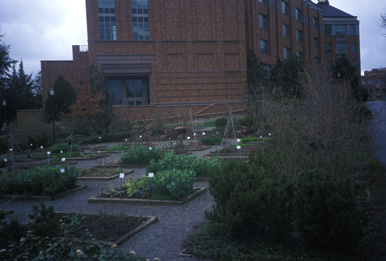
|
Medicinal Herb Garden
|
| The Seattle area boasts outstanding herb nurseries and public gardens.
The original and largest local herbal mecca is the University of
Washington Medicinal Herb Garden. It includes way more than only medicinal
herbs. There are culinary herbs such as chives, sorrel, and radish; fiber
plants such as flax and ramie; dye plants of many colors; even purely
ornamental shrubs and trees. The garden was started during World War I, when
we desperately needed drugs for our troops. But rather than detailing
the history, let's tour in prose through the garden. |
| Tours start at Cascara Circle, a cozy enclosure ringed by mostly
native shrubs and trees, featuring a little brick pool and stream for water
plants. Guarding Cascara Circle's entrance are two monkey sculptures. |
| Head east into section A to gravel paths and formal
wood-edged rectangular beds, mostly containing two herb species. But giant
fennel (Ferula communis) is so enormous it hogs an entire bed in the
corner nearest to the looming brick Chemistry building. |
| Between section A and B is a slope of lavender cotton,
hot-flavored thyme, and irises. Go right now and smell the blooming thyme and irises. |
| Section B has the maintenance shed and bus shelter, plus many
shrubs and trees, including sugar maple, chinaberry, smoke tree, myrtle,
boxwood, bay laurel, fig, pomegranate, cornelian cherry and yews. |
| Cross the road to section C, a spacious area with huge boulders at
its north, and Stevens Way to its south. Plants here include French
tarragon, sharing space with garlic chives; valerian, just beginning to open
its potently fragrant flowers; catnip, a gray-green shrublet in the same
bed as Echinacea; candy mint, purplish and smelling sublime; and fuki,
with leaves 2 feet wide like giant plates. |
| Next is the long narrow section D. As you enter you're flanked by
the state's largest crape-myrtle tree and a silverleaf holly hedge. In
this section is goldenseal, already done blooming; just east of it is an entire
bed of colt's-foot. Near the towering giant sequoia at the end is a bed of
native wild ginger and eastern American Jack in the pulpit. |
| Section E has the marsh mallow, whose thick felty leaves you
may stroke. It is a kind of mallow which grew in marshes. People used its
roots to make the confectionbefore synthetic substitutes became
prevalent. There is also smoking tobacco, recently set out and so quite
small. Beacon-like bright yellow wintercress flowers are cheerful. The pile
of lumber you see is being used by volunteers to rebuild the old rotting
bed borders. |
An amazing 5 foot high stand of rosemary in full bloom
separates section E and F. Notice that F is run down. It needs help. The garden
is full of hundreds of kinds of fascinating labeled plants, is a swell place
to visit and learn, but it is very low on the U.W. hierarchy of priorities,
so most of its improvements and the plant labeling are from a support
group. For tours, exact directions, etc., call 543-1126.
|
(originally published in The Seattle Weekly, May 1997)
Back |
|
|

